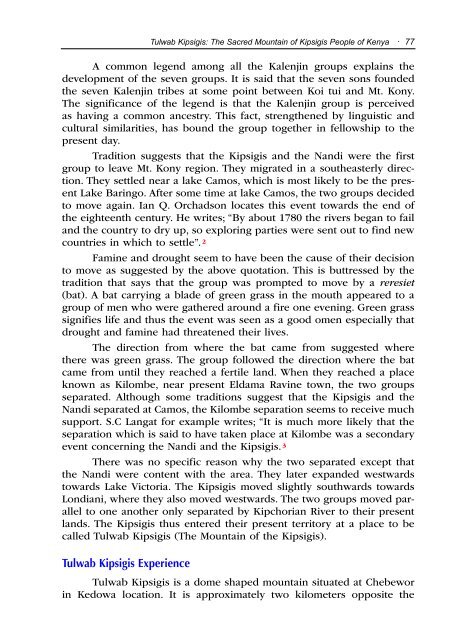voices-2013-2&3 - EATWOT's International Theological Commission
voices-2013-2&3 - EATWOT's International Theological Commission
voices-2013-2&3 - EATWOT's International Theological Commission
You also want an ePaper? Increase the reach of your titles
YUMPU automatically turns print PDFs into web optimized ePapers that Google loves.
Tulwab Kipsigis: The Sacred Mountain of Kipsigis People of Kenya · 77A common legend among all the Kalenjin groups explains thedevelopment of the seven groups. It is said that the seven sons foundedthe seven Kalenjin tribes at some point between Koi tui and Mt. Kony.The significance of the legend is that the Kalenjin group is perceivedas having a common ancestry. This fact, strengthened by linguistic andcultural similarities, has bound the group together in fellowship to thepresent day.Tradition suggests that the Kipsigis and the Nandi were the firstgroup to leave Mt. Kony region. They migrated in a southeasterly direction.They settled near a lake Camos, which is most likely to be the presentLake Baringo. After some time at lake Camos, the two groups decidedto move again. Ian Q. Orchadson locates this event towards the end ofthe eighteenth century. He writes; “By about 1780 the rivers began to failand the country to dry up, so exploring parties were sent out to find newcountries in which to settle”. 2Famine and drought seem to have been the cause of their decisionto move as suggested by the above quotation. This is buttressed by thetradition that says that the group was prompted to move by a reresiet(bat). A bat carrying a blade of green grass in the mouth appeared to agroup of men who were gathered around a fire one evening. Green grasssignifies life and thus the event was seen as a good omen especially thatdrought and famine had threatened their lives.The direction from where the bat came from suggested wherethere was green grass. The group followed the direction where the batcame from until they reached a fertile land. When they reached a placeknown as Kilombe, near present Eldama Ravine town, the two groupsseparated. Although some traditions suggest that the Kipsigis and theNandi separated at Camos, the Kilombe separation seems to receive muchsupport. S.C Langat for example writes; “It is much more likely that theseparation which is said to have taken place at Kilombe was a secondaryevent concerning the Nandi and the Kipsigis. 3There was no specific reason why the two separated except thatthe Nandi were content with the area. They later expanded westwardstowards Lake Victoria. The Kipsigis moved slightly southwards towardsLondiani, where they also moved westwards. The two groups moved parallelto one another only separated by Kipchorian River to their presentlands. The Kipsigis thus entered their present territory at a place to becalled Tulwab Kipsigis (The Mountain of the Kipsigis).Tulwab Kipsigis ExperienceTulwab Kipsigis is a dome shaped mountain situated at Chebeworin Kedowa location. It is approximately two kilometers opposite the





